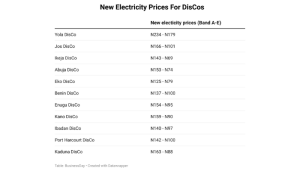Maureen Aguta
The Federal Government Thursday commenced implementation of the new electricity tariff for Band A consumers raised by over 240 per cent.
The new cost per unit of electricity (kWh) is expected to vary depending on the distribution company (DisCo) and the customer’s consumption level on the back of the increasing inflation rate and the impact of the foreign exchange rate and high cost of gas, which may push up the amount paid by customers without government’s subsidy.
Advocacy Times findings showed customers under Yola DisCo will pay between N234 and N179 per kWh, while those under Jos DisCo will pay between N166 and N101 per kWh.
Ikeja Electric customers will pay between N143 and N69 per kWh, while Abuja DisCo customers will be charged between N153 and N74 kWh. Eko DisCo’s rates range from N125 to N79 per kWh.
Benin DisCo’s charges fall between N137 and N100 per kWh. Enugu DisCo customers will pay between N154 and N95 per kWh, and Port-Harcourt DisCo’s rates range from N142 to N100 per kWh.
Kano DisCo charges vary between N159 and N90 per kWh depending on the customer’s band. In Kaduna DisCo, the rates range from N163 to N88 per kWh, while Ibadan DisCo’s charges are between N140 and N97 per kWh.
Electricity Tariff: Simple guide to check if you’re on Band A, B, C, D or E
In this article is a simple guide to help customers figure out which electricity feeder band they’re in,
The Nigerian Electricity Regulatory Commission on Wednesday approved a sharp increase in electricity tariffs for customers classified under Band A.

According to Musliu Oseni, the Vice Chairman of NERC, customers in this category will now be charged N225 per kilowatt-hour (KW/h), a significant rise from the previous rate of N66.
Band A customers are those who receive 20-24 hours of electricity supply daily.
Subscribers under Band B enjoy 16 to 20 hours of power supply, while those in Band C receive 12 to 16 hours daily.
Band D subscribers benefit from eight to 12 hours of power supply each day, and Band E subscribers only receive four to eight hours of electricity supply daily.
However, the tariff increment has sparked controversies regarding the classification of subscribers, with many fearing they may be charged more than their actual consumption.
To this end, we’ve put together a simple guide to help customers figure out which band they’re in, according to the Ikeja Electricity Distribution Company:
How to know your electricity feeder band
- Visit www.ikejaelectric.com
- Click on customer service
- Click on Customer feeder information
- Click on customer feeder verification
- Enter your account or meter number to verify your feeder details.


